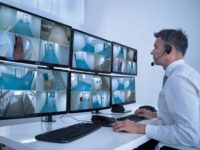10 tips for better security, safety and business intelligence

Integrated surveillance and security networked systems are widely recognized as the standard for today’s enterprise applications, providing numerous functional and financial benefits. In addition to their intended use, these systems are increasingly deployed in applications that transcend conventional security for a more proactive approach to video surveillance using new business intelligence sources and big data. This shift to proactive security is driven by the superior image quality of today’s cameras as well as the advanced functionalities, such as embedded analytics, that were not possible with older technologies. Video streams can now be remotely accessed by security administrators via laptops, mobile phones and more. Plus, today’s IP surveillance systems are more cost-effective than ever, and with meaningful integrations they can deliver a high return on investment (ROI) with volumes of data for various enterprise business and operations applications.
However, the overarching objective for any IP surveillance system is to meet each end user’s specific needs and requirements. A robust, well-designed and implemented system should deliver: 1) proactive analysis to help detect and prevent incidents from escalating before they cause harm to people and property, 2) accurate video and data for forensic investigations and 3) a system that is seamlessly integrated with other physical security systems such as access control, to provide a single management and control platform.
To help you get the most from your investment in video surveillance, here are ten tips for designing and implementing your system:
- Define Operational Goals and Challenges
A video surveillance system requires a complete understanding of it will be used to achieve the desired ROI. The benefits must then be communicated to the C-suite to secure approval and funding. All operational goals must be understood including:
- How much resolution is needed?
- What types/configurations of cameras are needed on a site-by-site basis?
- How long must video be retained for security, legal or compliance purposes?
- What specific areas, indoor and outdoor, need to be covered and why?
- What analytics are required at specific camera locations?
The answers to these questions will help define the parameters of your new or upgraded surveillance system.
- Optimize Security Budgets Wherever Possible
Budgets are a decisive factor at virtually every organization, and most security professionals are not willing to sacrifice features, quality or effectiveness when it comes to maintaining the security of their enterprise. It can be a challenge to find the optimal solution that not only solves problems but also fits into budgets. Savings can be found by selecting a video management system (VMS) with no recurring fees that also supports an open platform to ensure easy integrations and scalability.
- Move at Your Own Pace
Sometimes a new installation or system upgrade is best achieved in phases, particularly to accommodate budget availability, hiring or training needs, operational disruptions and other factors. Look at deploying cameras and supporting devices where they are needed most to address immediate challenges and build onto the core system in a prioritized order. This scenario lets organizations start small according to their surveillance and security priorities, limiting the initial financial burden and allowing more time to amortize the initial capital investment.
- Clearly Define Storage Needs
Higher resolution cameras with greater video frame rates require more network bandwidth and storage space, in turn increasing your overall spend. This is a true cost-performance issue that can greatly impact the final cost of your system installation. By implementing an advanced VMS solution and the latest compression technologies, you can effectively control these costs by only recording motion-activated or alarmed cameras at full resolution and fast frame rates, which cost-effectively optimizes both network and server utilization without degrading video quality.
- Determine Staff Cost for System Administration
Personnel costs are directly related to how easy your new surveillance system is to learn and operate. This will impact the overall cost and ROI of the new system and will influence the selection of the VMS and cameras. For example, casinos require 24/7 live monitoring for general security areas, with more specific compliance regulations applied to gaming areas. In this instance, parking lot surveillance may be well-served with video analytics that alert security personnel of incidents or events to investigate. Automating surveillance functions for specific areas and applications can greatly reduce the need for personnel to monitor live camera feeds, effectively reducing overall operations costs.
- Consider Future Integration Needs
Look for VMS solutions built with open architecture to more easily accommodate third-party integrations, thus providing greater flexibility and cost savings when adding new system enhancements. Leading suppliers have a range of solutions that can add functionality, automate routine tasks and solve project needs. Leverage them when possible.
- Remember Cybersecurity
Unfortunately, hackers have discovered that often the easiest gateway to organizations’ network data is through networked surveillance and security systems. These attacks are most commonly the result of not changing factory passwords on devices during installation and/or not upgrading device firmware, both of which are easy to address at the onset of a project. Be sure that your surveillance, security and any IoT devices connected to your security system infrastructure contain hardened architecture and data encryption capabilities and comply with your organization’s cybersecurity policies and procedures.
- Eliminate Licensing Requirements
Most surveillance and security software solutions have licensing requirements, software upgrade plans or service agreements that can result in substantial recurring costs. It is critical that you clearly understand all costs and associated details of those licensing requirements. The best bet is to select solutions that do not have licensing agreements, which will ultimately provide substantial savings during installation and over time.
- Calculate Environmental Conditions
Conditions such as extreme heat, cold, humidity, corrosion and high dust levels help determine what edge devices are viable for each installation location inside and outside of a facility. Some locations such as the Northeast or extreme South experience dramatic seasonal changes in temperature, humidity and ambient light levels. Any devices earmarked for outdoor applications need to be able to withstand these extremes.
- Redundancy
Surveillance and security systems need to be operational and accessible 24/7/365, which drives the need for redundancy and . This can be accomplished in many ways; with the installation of sufficient battery backup for primary systems, on-board camera recording in the event of centralized network failure and even cloud and off-site storage. Include budgeting for “failover” recording resources. Check for mandates for your specific industry, location and business application to ensure compliance.
Planning and implementing a new or enhanced surveillance and security system can add tremendous value across the enterprise. If you follow the proper steps when planning and selecting your system software, cameras and associated edge devices, your organization will be rewarded with better security, safety and business intelligence.
This article originally ran in Security, a twice-monthly security-focused eNewsletter for security end users, brought to you by Security Magazine. Subscribe here.
Looking for a reprint of this article?
From high-res PDFs to custom plaques, order your copy today!






